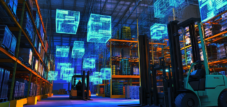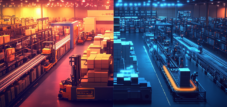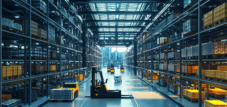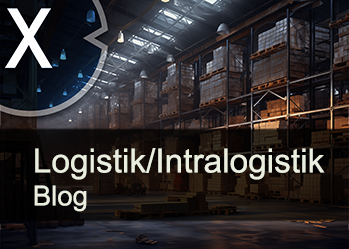Smart warehouses with warehouse automation and AI: Why warehouse automation is becoming the heart of the supply chain
Xpert pre-release
Language selection 📢
Published on: January 18, 2025 / Updated on: November 28, 2025 – Author: Konrad Wolfenstein

Smart warehouses with warehouse automation and AI: Why warehouse automation is becoming the heart of the supply chain - Image: Xpert.Digital
Efficiency, security, scalability: modern warehouse logistics put to the test
Respond in real time: Why automation is at the heart of the supply chain
The automation of warehouses has become enormously important in recent years. Companies in all industries are faced with the task of making their logistics processes ever faster, more precise and more cost-effective in order to meet the growing demands of the market. Warehouse logistics plays a central role here, as it often determines how efficiently and reliably a company can actually operate. Traditionally, many work steps in warehouses were carried out by people - from goods receipt and storage to picking and packaging. However, automated systems, robots and digital technologies have now found their way into warehousing and are opening up new potential that goes far beyond what was achievable with purely manual processes.
The following explains the most important reasons for warehouse automation, discusses challenges and risks, and provides an outlook on future developments. In addition, it will be examined to what extent these trends differ internationally, what effects they have on the labor market and what role legal framework conditions play. The text illustrates that warehouse automation is not only a technological development, but also a strategic, economic and social one.
Suitable for:
Reasons for warehouse automation
Automating warehouse processes has numerous advantages. Many companies are faced with increasingly complex and fast-moving demand and therefore need to align their warehouse processes to remain flexible and resilient. At the same time, costs should be saved, efficiency increased and customers satisfied. “Warehouse automation is no longer a luxury, but rather a decisive competitive factor,” as it is said in some industries. The main reasons for introducing automated warehouse systems can be summarized as follows:
1. Increased efficiency
A central goal of warehouse automation is to accelerate processes. Automated systems are able to identify, transport, store and remove goods from the warehouse when necessary without the need for human intervention. This not only saves working time, but also prevents idle time. Autonomous mobile robots (AMR) or driverless transport systems are already transporting goods in many warehouses. This shortens throughput times and allows picking orders to be carried out more quickly.
2. Cost reduction
In an automated warehouse, personnel costs are reduced, especially for activities that in the past involved a lot of physical effort and repetitive tasks. With robotics and automated shelving systems, companies can also make better use of existing storage space. High-bay warehouses or shuttle systems enable more efficient storage density, which in turn reduces space requirements and helps reduce operating costs.
3. Improved accuracy
Human errors can never be completely avoided, even with practiced skills. Automated systems, on the other hand, work very precisely and standardized. This is particularly evident in the picking of small parts, where robots or automated systems can identify goods and make them available in the right quantity. “High accuracy in picking is considered one of the most important factors for a successful supply chain,” is often heard in logistics departments. Because fewer shortages and incorrect deliveries mean satisfied customers and fewer returns.
4. Faster picking and shipping processing
Orders can be processed more quickly through automated picking and transport systems. This is particularly relevant for companies that want to distinguish themselves from the competition through short delivery times or even offer same-day delivery. The importance of short delivery times has increased massively, especially in the e-commerce industry.
5. Increased security
Automated systems reduce the risk of workplace accidents because heavy and potentially dangerous tasks no longer need to be carried out by humans. Robots take over the lifting of heavy loads, driverless transport systems reduce the risk of collisions and intelligent monitoring systems can detect and avoid dangerous situations in advance. This leads to a generally higher level of safety in the warehouse.
6. Optimal use of space
Automated high-bay warehouses often use the height of a building to its limits. In this way, a large volume of goods can be stored even in smaller storage areas. Additionally, compact storage systems allow unused space to be minimized. Well-thought-out planning of the storage structure ensures that there are as few walking paths as possible and that every parking space is optimally occupied.
7. Flexibility and scalability
Many modern storage systems are modular and can be easily expanded as business volumes grow. A company can therefore start small and later purchase additional modules or robots when demand increases. “The ability to react quickly to market changes is essential for modern logistics,” is often said in the industry. Flexibility is not just a buzzword, but actually a decisive criterion when planning automated storage solutions.
8. Coping with increasing demands
More and more customers want personal, tailor-made orders and extremely short delivery times. This increases the pressure on warehousing, where it is no longer sufficient to ship large batches of identical products. Individual order processing often requires that many different items be picked in a very short time. Automated systems with intelligent software can make this possible efficiently, for example by automatically bringing together goods from different areas.
Future trends in warehouse automation
Warehouse automation is constantly changing and is constantly influenced by new technical developments. Companies that invest in these technologies early on create significant competitive advantages. At the same time, customer expectations are increasing when it comes to delivery times, flexibility and transparency. “Only those who continuously adapt to market needs will remain successful in the long term” is a common finding in many industries. Key trends include:
1. Advanced robotics
Robots are becoming increasingly versatile and adaptable. New sensor technologies and artificial intelligence enable them to automatically recognize and handle objects of different sizes and shapes. This means that a single robot can take on various tasks such as picking, packaging or palletizing. The so-called cobotic – the close collaboration between humans and robots – also plays an increasingly important role in making automation flexible and human-centered.
2. Artificial intelligence (AI) and machine learning
AI systems analyze large amounts of data to make forecasts and make autonomous decisions. In a warehouse context, for example, this means that a system recognizes in real time which items will soon be out of stock and should therefore be replenished with priority. AI can also help optimize routes by calculating the most favorable schedule for autonomous transport systems. This makes forecasts about seasonal peaks or short-term changes in demand more precise.
3. Internet of Things (IoT)
Sensors and connected devices in “smart warehouses” enable real-time monitoring of all warehouse activities. During incoming goods inspection, the system immediately registers when a new pallet arrives, records its position and compares the information with the order data. IoT solutions also record temperatures, humidity and other environmental factors, which is particularly important in industries such as the food industry to ensure compliance with the cold chain. “Transparency is a key success factor in the supply chain,” say experts, and the IoT forms the technological basis for this.
4. Autonomous Mobile Robots (AMR)
AMR differ from classic driverless transport systems in their ability to dynamically plan their route and avoid obstacles. This means they can be used particularly flexibly, for example in warehouses with changing layouts or areas where people and robots work together. AMR can bring goods from one place to another around the clock, set up temporary storage or deliver goods directly to order pickers' workplace. This shortens travel times and increases the overall performance of the warehouse.
5. Goods-to-person picking
Instead of employees walking through the warehouse looking for items, the items come to them automatically. Highly automated storage systems ensure that a robot or an automatic storage and retrieval device removes the required goods from the compartment and brings them to the picking station. This way of working not only saves time, but also relieves the burden on staff as long distances and heavy lifting are no longer necessary. This method is particularly attractive for companies that have a high picking frequency and want to increase throughput in the warehouse.
6. Smaller warehouses, higher activity
A trend that is becoming increasingly important as a result of urbanization and e-commerce is the establishment of small, decentralized warehouses closer to the end customer. Since space in metropolitan areas is expensive, the focus is on highly automated concepts that enable maximum use of space. Micro-fulfillment centers, which are densely integrated into urban areas, also rely on automated systems to deliver orders within a few hours. “Proximity to the customer is becoming increasingly important in modern logistics,” is a common assessment.
Global developments and differences
Warehouse automation is a phenomenon that is spreading worldwide, although not at the same speed in all regions. Economic and cultural factors influence how quickly and in what form automation takes place:
USA
Although the United States is known as a high-tech nation, many warehouses still have a relatively high manual workforce. At the same time, there are leading technology companies that develop highly innovative solutions. One reason for the previously hesitant adoption of automatic storage solutions was that labor costs in some regions have traditionally remained comparatively cheap. But in view of rising wage levels and tighter labor markets, a rethink is beginning here.
China
China is investing heavily in robotics and artificial intelligence. The country is considered a pioneer in the use of advanced robotic systems in huge warehouses. The high dynamism of the Chinese market and the highly competitive e-commerce sector have led many companies to quickly automate to achieve short delivery times and low costs. Government funding programs also accelerate this process.
South Korea
South Korea is known for its high affinity for technology and its pioneering role in innovation. In many companies, warehouse automation is already being pushed very far, supported by an excellent infrastructure in the areas of digitalization and robotics. The focus here is often on high-end solutions that are very sophisticated and reliable.
Germany
Germany is traditionally an industrial country with a strong mechanical engineering and automotive industry. While there are numerous manufacturers of conveyor technology and robotic systems, the potential of warehouse automation is not always fully exploited in all industries. The reasons are the sometimes high initial investments and the complexity of integrating automated systems into existing production and logistics chains. Nevertheless, more and more companies are relying on automation in order to survive in global competition in the long term.
Suitable for:
- Warehouse automation worldwide: A comparison between Germany, Japan, France, Spain, Italy, Poland and the Czech Republic
- Warehouse automation globally: A comparison between the USA, China and South Korea - in the USA there are currently 80% manual warehouses!
Examples of successful implementation
Warehouse automation is taking place in many industries. A few examples illustrate how wide the range of applications is:
E-commerce
Time is a crucial factor here. In order to ship orders as quickly as possible, large online shops use highly automated sorting and picking systems that run around the clock. Numerous robots navigate through the warehouse, pick up goods from shelves and bring them to centrally located packing stations. This means that enormous order volumes can be handled in a very short time.
Automotive industry
Just-in-time deliveries are essential in automotive manufacturing. Automated warehouses ensure that parts and components are available exactly when they are needed for assembly. Otherwise, errors or delays can result in high costs. High-bay warehouses are usually used, which are directly networked with production systems and control the flow of materials.
food industry
The use of automated cold storage and high-bay systems makes it easier to maintain the cold chain. This means the products stay fresher for longer and do not spoil, while at the same time the enormous volume of frozen or perishable products can be efficiently controlled. Special robots can also handle palletizing and thus better comply with hygiene and safety standards.
Palletizing
Palletizing plays a central role in many industries, whether e-commerce, retail or food. Automated palletizing systems stack goods layer by layer, so that transport and storage space is optimally used. This minimizes damage during transport and handling because the systems work with consistent precision. “Efficient palletizing is the key to loading more goods in less time,” is often emphasized.
LTW Solutions
LTW offers its customers not individual components, but integrated complete solutions. Consulting, planning, mechanical and electrotechnical components, control and automation technology, as well as software and service – everything is networked and precisely coordinated.
In-house production of key components is particularly advantageous. This allows for optimal control of quality, supply chains, and interfaces.
LTW stands for reliability, transparency, and collaborative partnership. Loyalty and honesty are firmly anchored in the company's philosophy – a handshake still means something here.
Suitable for:
Smart warehouses and co.: Are automated warehouses the future of logistics?
Challenges and risks of warehouse automation
As beneficial as automating a warehouse can be, it also poses various challenges and risks. Companies should understand these factors before committing to full-scale automation:
1. High investment costs
The purchase and integration of automated systems is sometimes associated with considerable costs. In addition to the actual systems, planning, software implementation, staff training and subsequent maintenance should not be underestimated. The return on investment (ROI) often only occurs after several years. This is a financial burden, particularly for small and medium-sized companies, which must be carefully calculated.
2. Complexity of systems
An automated warehouse only works smoothly if all components – from the robots to the racking systems to the warehouse management software – are optimally coordinated with one another. Even the smallest disruptions can paralyze operations. “A high degree of networking requires careful planning and reliable maintenance management,” says many specialist articles. Faulty interfaces or inadequate emergency concepts quickly lead to production and delivery delays.
3. Dependence on technology
If an automated system fails, it can have a serious impact on the entire supply chain. Whether due to a robot defect, a software error or a power failure - in highly automated environments, a single defect can delay or completely stop all processes. It is therefore essential to have a redundant concept in which alternative processes or systems are provided to compensate for failures.
4. Data security and cyber attacks
As connectivity increases, the risk of falling victim to cyberattacks or data leaks also increases. Criminals could try to manipulate control software or steal valuable data about inventory levels and delivery schedules. A comprehensive security concept that protects both physical and digital access is essential. This includes regular software updates, firewalls, encryption and employee training in dealing with IT security.
5. Reduction of warehouses as activity increases
Many companies rely on compact high-bay warehouses or automated shuttle systems, but these also have limits. Especially when activity and the range of items increase significantly, a warehouse must be sufficiently sized to handle the flow of goods. Space-saving solutions such as micro-fulfillment centers are highly automated, but with rapid growth they quickly reach capacity limits and need to be expanded.
6. Dangers in the camp
There are still dangers from falling objects or from carelessness, for example when people move in the same rooms as transport robots. Although automated systems minimize many risks, they also require a rethink in security management. Employees must be trained in how to use robots so that no one accidentally comes into the operating range of machines or collisions occur.
Impact on the world of work
Warehouse automation significantly changes working conditions and requirements. On the one hand, some jobs will be eliminated, especially those that involve repetitive manual tasks. On the other hand, new fields of employment are emerging, particularly in the areas of software, data analysis, system planning and maintenance. “Where robots drive, people have to program, monitor and optimize,” is what is often argued.
This change presents many companies with the challenge of training their workforce accordingly. It is not enough to simply introduce the technology. Employees need training to be able to operate, monitor and maintain the systems. In addition, the demands on analytical skills are increasing as data plays an increasingly larger role - from inventory management to process optimization. This requires specialists who can handle big data and artificial intelligence systems.
There is also an ethical question as to how automation should be designed so that it not only reduces the need for personnel for cost reasons, but also creates humane working conditions. “Automation must not devalue human work, but should complement it,” it is often said. Companies and society must ensure that the benefits of automation reach everyone and that social aspects are adequately taken into account.
Warehouse automation in the German context – an international comparison
Germany has a mature industry and broad expertise in mechanical engineering. Despite this advantageous initial situation, many warehouses are still operated manually. For a long time, it was sufficient for many companies to operate proven manual or semi-automated solutions, especially since the investment costs for fully automated systems are high. However, there has recently been a realization that without automation, one could be at a disadvantage in global competition in the long term.
Other countries such as China or South Korea show how the path to highly automated warehouses can be accelerated if the economic structure is geared towards rapid innovation cycles and digital transformation. Both large companies and medium-sized companies there rely more consistently on extensive automation and robotics than in Germany. In the USA, the picture is mixed, as there are extremely highly automated logistics centers for large corporations as well as largely manual warehouses in traditional industries.
In Germany, the obstacles are not only financial, but also organizational. However, a strong engineering culture ensures that new technologies are carefully examined and introduced in a considered manner. As soon as the advantages are clear and the ROI is given, companies usually get involved quickly and comprehensively. In addition, the close connection between research institutions, mechanical engineering and technology start-ups promotes new developments.
Costs and profitability of automated storage systems
The specific investment costs for warehouse automation depend on many factors - from the warehouse size to the level of automation to the technologies used. Simple automation with driverless transport systems is cheaper than a fully automated high-bay warehouse with robots and complex control solutions. In addition, every new technology causes follow-up costs for maintenance, software updates and spare parts.
Automation is usually economically worthwhile if the warehouse has a certain minimum size and complexity or if there are extremely high demands on delivery times and accuracy. Companies typically calculate ROI based on expected savings in personnel costs, reduction in error rates and returns, and increased utilization of warehouse space. Soft factors such as improved job security or increased customer satisfaction can also be taken into account. Depending on the industry and level of automation, it can take between one and seven years for the investment to pay off.
Suitable for:
Legal and regulatory framework
Anyone who operates an automated warehouse must comply with various legal requirements. This includes:
Safety regulations
Machinery guidelines and occupational safety regulations define what safe operation should look like. For example, automated systems must be protected by safety fences, light barriers or sensors so that people can stay near them safely.
data protection
Since automated warehouses often process personal data, for example to track orders, data protection laws apply that companies must comply with. Systems should be designed so that only authorized people have access to sensitive information.
Product liability
If damage occurs due to a faulty automated system, the question arises as to who is liable. Operators, manufacturers and software developers can be held responsible under certain circumstances. A clear contractual regulation is essential.
Labor law
Warehouse automation can reduce or change staffing requirements. However, companies are obliged to comply with applicable labor law regulations in the event of job cuts or changes and - if available - to involve works councils in a timely manner.
Although many governments are promoting digitalization and automation as a driver of innovation, protecting employees and customers remains a valuable asset. Companies must therefore check early on which laws and standards are relevant for their specific automation process.
Warehouse automation will continue to gain in importance in the coming years
“Innovative technologies in warehouses have long been more than just a trend, they are the key to high competitiveness,” emphasize industry experts. The rapid developments in e-commerce and the desire for the shortest possible delivery times alone make automation indispensable for many companies. At the same time, expectations for flexibility and customer-specific order processing are increasing, which can hardly be achieved without the intelligent interaction of robotics, AI and IoT.
A central element of the future vision of automated warehouses are so-called “smart warehouses”. These connect all systems with each other so that all information is available in real time. AI-based algorithms plan and optimize the warehouse processes, while robotics and driverless transport systems take over the physical process. This means that the individual systems can constantly adapt to changes – such as fluctuating order quantities, short-term peak times or delivery bottlenecks.
However, companies that decide to automate should not only focus on the technological aspects. It is equally important to involve employees, expand their skills and train them in how to use the new technologies. Only then will automated storage systems develop their full potential and lead to a real improvement in competitiveness. Ethical and social issues are also on the agenda to ensure that the benefits of automation reach everyone involved.
Automation is therefore not a purely technical matter, but rather a strategic one that permeates all areas of the company. Careful planning, a realistic cost-benefit analysis, compliance with legal requirements and the qualification of staff are central prerequisites for success. However, with the right approach, the benefits of automated warehouses can be enormous: increased efficiency, lower error rates, improved safety, higher customer satisfaction and a significant cost reduction. In a world in which supply chains are becoming increasingly interconnected and customer requests are becoming more and more specific, warehouse automation is an essential component of a modern and future-proof corporate strategy.
“Anyone who doesn’t invest in automated warehouse technology today will find it difficult to compete tomorrow,” is a conclusion shared by many experts. At the same time, it remains clear that this is not a sure-fire success. The technologies must be selected and continuously developed to suit the business model and the specific requirements. Adaptability, the willingness to innovate and a holistic understanding of operational processes determine whether warehouse automation will bring the desired added value in the long term.
Last but not least, it is important to keep an eye on rapid developments. Technologies such as autonomous drones for inventory tasks, the use of augmented reality for order picking processes or new, highly flexible robot arms that act even more precisely are already in the starting blocks. Advances in battery capacity and energy management could make driverless transportation systems even more efficient. And machine learning algorithms are becoming increasingly better at examining data for anomalies and potential for optimization. It is therefore to be expected that the pace of change in logistics will even accelerate.
Anyone who invests in these developments early on will gain a head start. It is worth developing a clear concept and understanding automation as a continuous process in which you proceed in stages and rely on modular solutions. This means the warehouse always remains adaptable and can be quickly restructured if necessary.
Overall, it is clear that warehouse automation is not a short-lived phenomenon, but a strong, global trend. It is changing business models, jobs and the understanding of how logistics should work in the 21st century. Well-planned and responsibly implemented automation projects can help companies survive in increasingly intense competition and at the same time meet increased expectations of quality, speed and reliability.
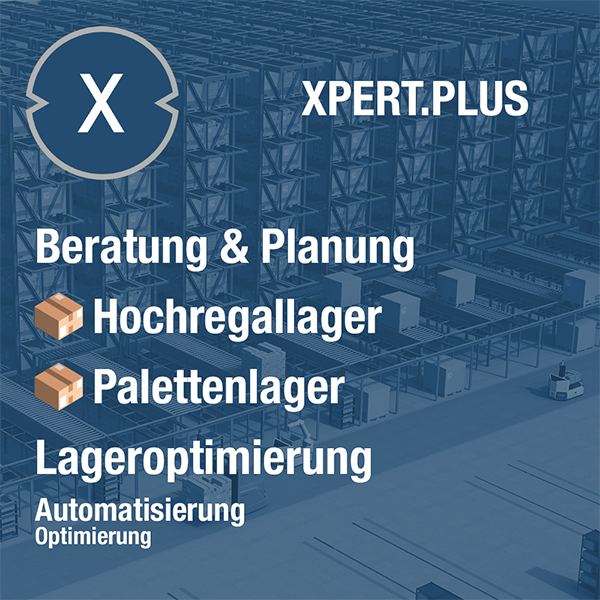
Xpert.Plus warehouse optimization - high-bay warehouses such as pallet warehouses consulting and planning
We are there for you - advice - planning - implementation - project management
☑️ Our business language is English or German
☑️ NEW: Correspondence in your national language!
I would be happy to serve you and my team as a personal advisor.
You can contact me by filling out the contact form or simply call me on +49 89 89 674 804 (Munich) . My email address is: wolfenstein ∂ xpert.digital
I'm looking forward to our joint project.






